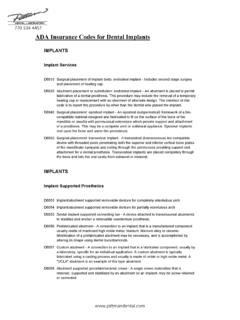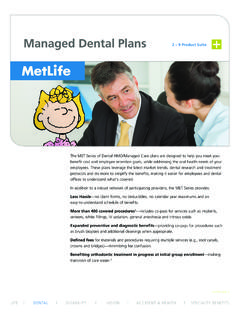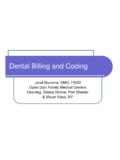Transcription of ARE YOU BILLING IMPLANT RESTORATIONS - Dental Code …
1 ORAL APPLIANCECOVERAGEThe diagnosis is the key To determine if an oral appliance will be covered by a Dental or medical plan, the coder first needs to know the diagnosis. If a nightguard is required because the patient grinds his teeth, D9940 should be reported and a narrative provided stating that bruxism is the diagnosis. However, if periodontal mobility is the problem, then a complete periodontal charting and diagnosis should be submitted along with D9940. Some Dental plans will also request a recent full mouth radiographic series to confirm the extent of the bone loss. If the patient is experiencing temporomandibular joint dysfunction (TMD) D7880 should be billed for the occlusal orthotic and a narrative provided stating the diagnosis and symptoms ( , joint pain, popping, clicking, crepitus, migraines, deviated opening, etc.)
2 What s the bottom line? Always check the chart for the diagnosis before you check the plan for benefits. ARE YOU BILLING IMPLANT RESTORATIONS CORRECTLY?With over 40 IMPLANT codes to choose from in CDT 2009/2010, den-tal teams often find IMPLANT codes confusing. Oddly enough, coding the IMPLANT surgery seems to be the easy part. Selecting the correct code(s) and receiving insurance reimbursement for the IMPLANT re-tained restoration can be challenging if the staff member coding the claim does not understand how the IMPLANT codes are organized. THE ABUTMENT APPEARS TO BE THE PROBLEM When it comes to coding RESTORATIONS on implants , the problem seems to be that some staff members do not realize that the term abutment no longer refers to the crown that anchors a bridge.
3 What dentistry used to refer to as an abutment as part of a traditional bridge proce-dure is now called a retainer. If you turn to pages 52 and 53 of the CDT 2009/2010 codebook, you will find codes for fixed partial denture retainers. In coding terms, a three-unit bridge is now identified as a retainer-pontic-retainer, not an , the term abutment refers to the connection device that attaches a restoration to a root-form IMPLANT . The connection device can be either prefabricated or custom. A prefabricated abutment (D6056) is one in which the IMPLANT manufacturer has fabricated an abutment to fit the company s manufactured IMPLANT . Prefabricated abutments may require adjustments using burrs or diamonds prior to placing the prosthetic crown and are often screw retained.
4 Custom abutments (D6057) are fabricated to the individual case, usually cast (or milled) by a Dental lab, and may still require some minor adjustments prior to placement of the prosthetic crown. BILL THE ABUTMENT SEPARATE FROM THE CROWN One of the most costly mistakes Dental teams make is that they fail to charge for the IMPLANT abutment separately. All too often, dentists lose money on IMPLANT dentistry because they charge a single fee that includes both the prosthetic crown and the IMPLANT abutment. When the fee for the abutment is combined with the fee for the prosthetic crown, the charge is certain to exceed the Dental plan s allowable fee for the crown. This creates the appearance to the patient that the dentist has overcharged for the crown (or retainer).
5 To make matters worse, participating providers are hit especially hard when they are instructed to write off fees above their contracted crown or retainer fee. By charging separately for the abutment, the patient may receive additional benefits for the abutment if his/her Dental plan offers IMPLANT Constructing a Narrative for Cracked Tooth 2 Calculating Write-offs When BILLING Multiple Plans ..Page 5 Dental Plans Looking for More Than Pocket Depths ..Page 7 Ever Wonder if Carriers Read Your Narratives? ..Page 11(Continued on page 4)Sample Issue 2009 DON T EAT THAT LAB BILL!It happens to most dentists sooner or later. Despite your best efforts, a patient doesn t show up to seat the crown, bridge, denture, etc.
6 You suspect the patient doesn t have the money because he failed to bring the required down payment at the impression appointment. You have invested a lot of time in the case and are now facing a hefty lab bill as well. What are your options? Promptly notify the patient s Dental plan of the situation and submit copies of your expenses. While not all insurance companies will respond favorably, many will consider reimbursement if given any discretion by the patient s Dental plan. The following is one of several testimonies from Dental practices whose expenses have been reimbursed:Dear Insurance Solutions,Here is an update to the situation I spoke to you about earlier.
7 We had a patient who requested a complete upper denture and a par tial lower denture. At deliver y, he was angr y that ever ything was not perfect. In his mind, if the dentures needed adjustment, they were not done right the first time, and he would not accept keep the peace, we refunded the amount he had paid and advised Delta Dental of Michigan of the situation. D elta D ental requested complete repayment. As you advised, we sent a check in the amount Delta requested along with a request for consideration of payment of the materials and lab fees we incurred in making the dentures. We sent copies of all invoices involved. Today, eight weeks later, we received a check reimbursing us for the total amount of the invoices sent.
8 We are glad we made the effor t and want to thank you for your helpful in MichiganCONSTRUCTING A NARRATIVE FORCRACKED TOOTH SYNDROMEC racked tooth syndrome can be difficult to diagnose and even more difficult to get paid. The tooth can look fine clinically and radiographi-cally, yet the patient still experiences pain. The dilemma is compounded when the patient cannot determine exactly which tooth hurts. Describ-ing this scenario to a Dental plan is not likely to get a crown claim paid unless additional information is information do Dental insurance consultants look for before approving a crown due to cracked tooth syndrome? After numerous conversations with Dental consultants, we have concluded that they primarily want to know how the dentist arrived at his/her diagnosis.
9 Consider the following questions when constructing a narrative for cracked tooth syndrome:Although the crack could not be seen on the radiograph, could it be seen clinically? If so, where was it? (Drawings are helpful.)Did the tooth have any existing RESTORATIONS or prior endo?What were the patient s symptoms? Pain upon biting or release? Which cusp? Was a tooth slooth used? How did the dentist differentiate the crack from a craze line? Was transillumination with magnification used?Did the dentist rule out other possible diagnoses? Does the radiograph verify that there are no periapical lesions? Did placing an ortho band alleviate the pain? When the answers to these questions are noted in the patient s chart, it is much easier for administrative staff members to construct mean- ingful narratives and obtain payment for cracked tooth syndrome.
10 Sample Narrative Chief Complaint: Pain when biting, symptoms present for several months Clinical Findings: Visible fx. into dentin on mesial & distal marginal ridge, pain to #19 DL cusp upon release of bite confirmed & crack verified during prep Differential Diagnosis: Pulpitis and apical osteitis ruled out by clinical diagnostic testingLOOKING FOR ROOT FRACTURES?Periradicular surgery is a term used to describe a variety of procedures performed on tooth roots. This includes surgery to the root surface, repair of a root perforation or resorptive defect, exploratory curettage to look for root fractures, removal of extruded filling materials or instruments, removal of broken root fragments, sealing of accessory canals, etc.



